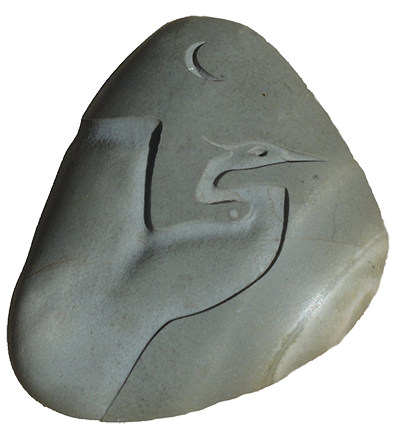
This first appeared in the Easing Awake Sangha Newsletter on September 4, 2015.
September 4, 2015

A smooth stone with the image of a flying crane carved into it sits on some papers on my desk. It’s pretty to look at and comfortable to hold.
It reminds me of a story my friend Jens told me a few weeks ago on retreat. When he was in Thailand, a monk placed a round stone on his palm and encouraged him to squeeze it tightly.
His hand began to hurt. So the monk said, “Now release your grip and relax your hand.” After a few moments he asked, “Does your hand feel better?”
Jens nodded.
Pointing to the stone the monk said, “Notice it hasn’t moved. Whether your hand hurts or feels good is not the fault of the stone. It’s what you do with it that matters. Hindrances are just stones we try to squeeze.”
Hindrance is the traditional term for the thoughts, feelings, and other disturbances that seem to pull the mind-heart away from the peace and wellbeing we seek in meditation. By extension, hindrances are anything in life that disrupts happiness and contentment.
The monk suggested hindrances are as organic and impersonal as stones. They are not a problem as long as we relate to them wisely.
I love the metaphor. It got me thinking about all the ways we relate to the stones in our hands. Rather than squeeze them and relax, we could hold on tightly a little longer. The hand will go numb or fall asleep and feel better. But a numb fist is not much use in typing on a computer, drinking a glass of water, or playing a piano.
Another way we could react to the hurt is to jump up and down and run around. This may distract us from the pain. But it makes contentment impossible.
Another response is to blame the stone and throw it away. This is popular because it relaxes the hand and lets us feel better … until the stone hits someone and they throw it back at us. This is a metaphor for much of the violence in human society.
In traditional Buddhism there are five principal kinds of hindrances: (1) grasping: gripping the stone tightly, (2) aversion: throwing the stone away, (3) restlessness: the mind that runs hither and yon, (4) sloth and torpor: the mind that goes numb or falls asleep, and (5) doubt and confusion: seeing the stone as the problem.
Regardless of the flavor of the hindrance, they all arise naturally out of the stress and strain of life. The mind likes to tell tales about them. If aversion arises, the mind might say, “He treated me poorly,” or “She had no right to say that.” If worry or restlessness arises, the mind might say, “How will I get it all done?” or “What will they think?” The mind tries to soothe us with stories and ideas about what’s going on. But they rarely help.
Believe it or not, at the core of all hindrances is a knot of tension that just wants to expend its extra energy so it can relax and disappear. The trick is to ignore the stories, concepts, ideas, and other contents of thought and shift awareness to the mood, attitude, or tone of the mind-heart. Then the knot of energy becomes noticeable. We can simply relax into it. This allows it to do what it always wanted – untangle itself and disperse.
As it dissolves, ease and insight are left in its wake. Wellbeing and wisdom are not qualities we can add to our experience. Rather they are what’s left behind when the tension softens and dissolves.
There is no need to do anything with hindrances. They are humble, impersonal messengers. Like the stone in the hand, they are not a problem if we listen to their essence and relate to them wisely.
Metta,
